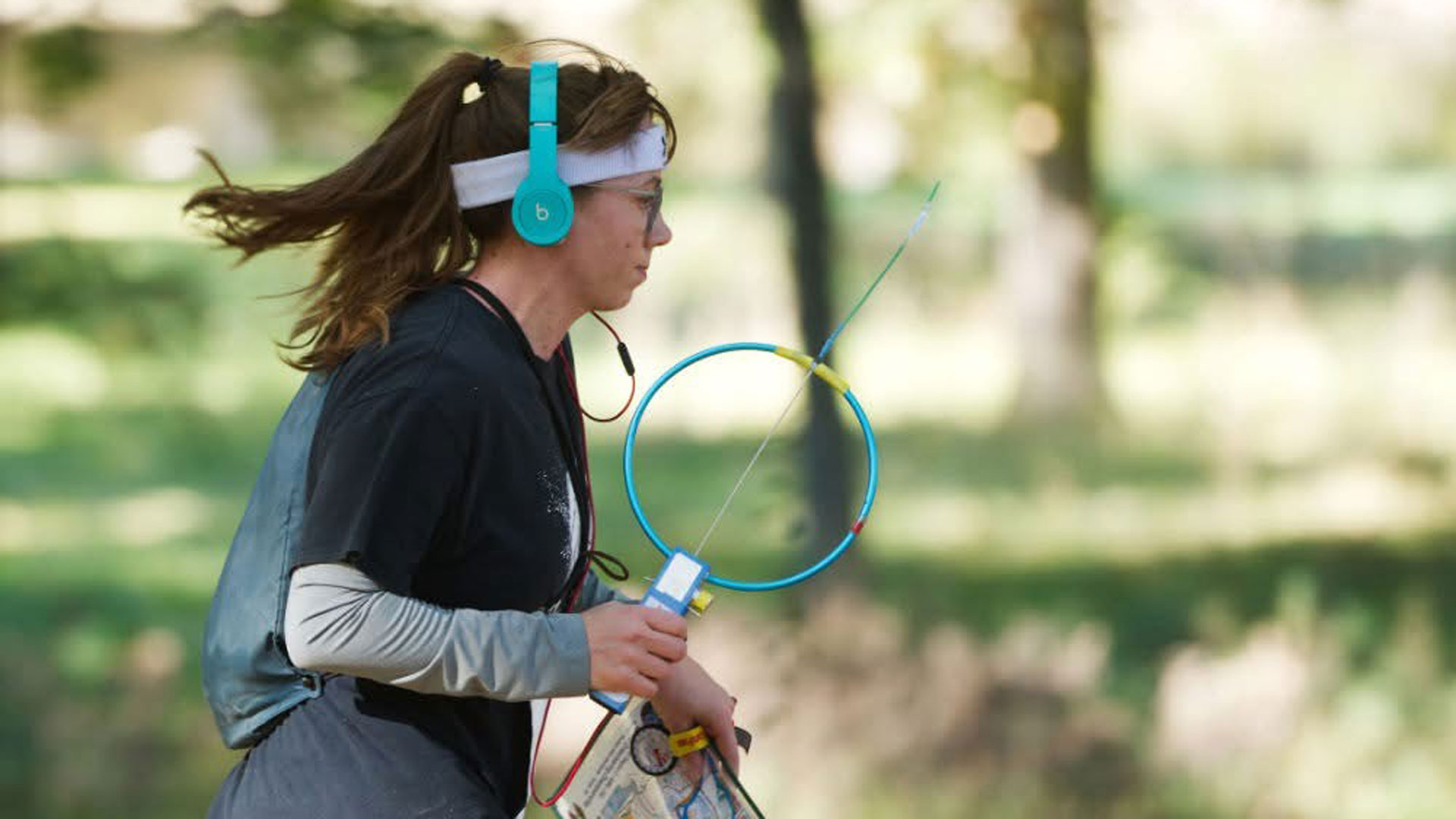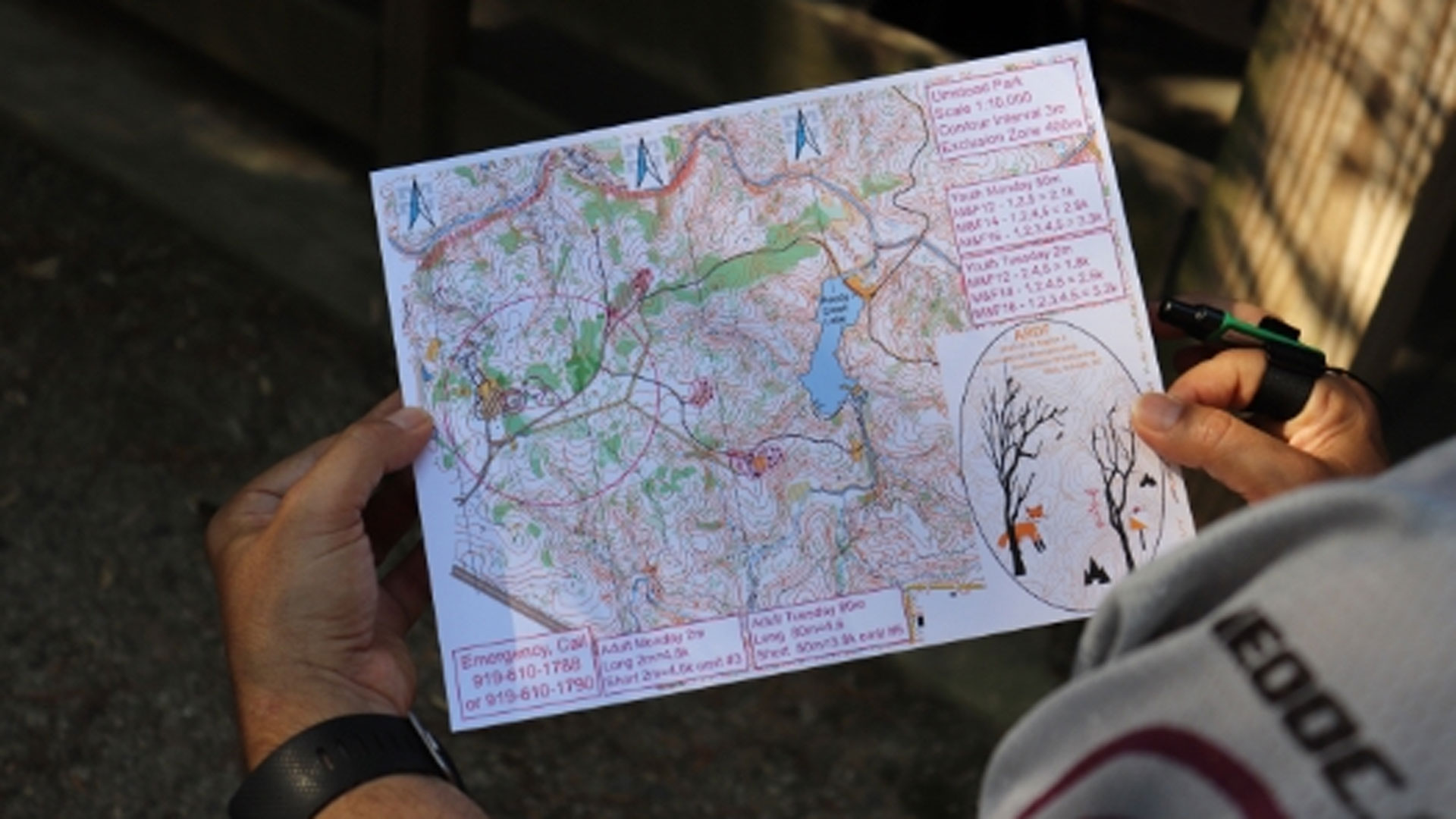How the Sport of Amateur Radio Direction Finding can Enhance US Army Holistic Health and Fitness and Electronic Warfare Training Objectives
By Lt. Col. Matthew G. Sherburne, P.E.
Article published on: July 1st, 2025 in the Gray Space Summer 2025 Edition
Read Time: < 8 mins

RDF participant sprinting towards thier next point. (Photo by Charles Scharlau, USA ARDF Co-Coordinator)
We are always seeking new and innovative ways to enhance the physical and cognitive training of our troops. When we find ways to combine the two, we can enhance the readiness our troops under the heavy demands of combat. One such training activity that supports the Army’s Holistic Health and Fitness (H2F) and electromagnetic warfare (EW) objectives is amateur radio direction finding (ARDF), also known as foxhunting, which is based on radio direction finding, orienteering and amateur radio. This national and international sport, also known as radio orienteering, has been around for many decades and combines the even older sport of orienteering with direction finding, which involves locating a radio transmitter. It requires both cardiovascular fitness and mental skill to traverse a course in the woods and urban environments at speed by locating four to five different transmitters. This training focuses on land navigation with a map and compass, the science of antenna and frequency propagation, and radio frequency (RF) direction finding. ARDF is a civilian sport that does not use military RF frequencies or equipment; it is an excellent training activity that any unit can establish either on or off base and has several national level events for U.S. Army personnel to compete. ARDF is an activity that will train our EW force to operate at peak physical and cognitive condition to meet the demands of near-peer adversaries.
During post-World War II, countries, particularly in Europe decided to enhance their military and civilian population expertise in radio direction finding while also honing their land navigation skills through the sport of orienteering. The sport of ARDF began in the 1950s and provided an important civil defense application during the Cold War.1 It demanded athletes run at neck breaking speeds through the woods to hunt down their beacons by taking multiple lines of bearing. Participants must demonstrate high cognitive ability while operating at peak fatigue to make it through the course. This is precisely the type of activity we need today. In a recent article from Army Times, it was reported that, “Army Vice Chief of Staff James Mingus told Soldiers at the Maneuver Warfighter Conference at Fort Moore, Georgia, … that the Holistic Health and Fitness program … will roll out across the entire force.”2 As H2F expands beyond just brigade combat teams (BCTs) and to all units, training activities are needed that units can easily employ. ARDF only requires inexpensive equipment, lots of training land, and an amateur radio licensed control operator.
Amateur radio is leveraged as the licensed means to operate the ARDF radio beacons. In the U.S. and its territories, the Federal Communications Commission (FCC) oversees amateur radio activity under Part 97 of Code of Federal Regulations Title 47 (Telecommunications).3 Specifically, there are five key purposes of the amateur radio service:
- To recognize and enhance the value of the amateur service to the public as a voluntary, non-commercial communication service, particularly in providing emergency communications.
- To continue and extend the amateur’s proven ability to contribute to the advancement of the radio art.
- To encourage and improve the amateur service through rules which provide for advancing skills in both the communication and technical phases of the art.
- To expand the existing reservoir within the amateur radio service of trained operators, technicians, and electronics experts.
- To continue and extend the amateur’s unique ability to enhance international goodwill.
Amateur radio governance and operation also exist in many other countries where U.S. forces are located, allowing personnel to engage ARDF around the world. The control operator of the radio beacons must be licensed at the level that authorizes transmission on the amateur radio frequency in use. In the U.S., the FCC has three levels of licensure:
- Technician Class: This license grants access to limited high-frequency (HF) spectrum but primarily allows operation on very high frequency (VHF) and above.
- General Class: This license includes all the privileges of the Technician Class, as well as additional access to HF spectrum.
- Amateur Extra Class: This license provides access to the entire amateur radio spectrum, across all bands.
There are two main bands on which ARDF is conducted: the 2-meter (144MHz) band and the 80-meter (3.5MHz) band. Amateur radio license preparation courses and exams are conducted near or even on many military installations.

ARDF participant studying a course map. (Photo by Charles Scharlau, USA ARDF Co-Coordinator)
Bringing ARDF to your location is an easy process. Setting up ARDF as either a physical training activity or full-scale competition requires finding training land or cantonment areas in which event support personnel will place orienteering flags and amateur radio beacons. It also requires that these areas are mapped to 1:10000 or 1:15000 to allow for the orienteering level of detail required for the sport. Once an area is mapped under the International Specification for Orienteering Maps 2017-2 (ISOM)4, event organizers will then select locations to place the RF beacons, or foxes, as the community colloquially calls them. With a member of the unit that has earned their amateur radio license, they can setup ARDF beacons with their callsign that gets transmitted automatically by morse code. Event organizers can also use the callsign of a hosting amateur radio club.
The foxes can be built in-house with economical parts. Handheld direction-finding sets are sometimes hard to find on online marketplaces, but they can be built using readily available parts and make for a fun and academic maker lab experience amongst the EW force. There are two new open-source projects underway in the maker space: SignalSlinger5, an 80-meter transmitter, and SignalSnagger6, an 80-meter direction finding receiver with a rough cost of $100 for parts and materials for each. A typical ARDF course will have four to five foxes, along with reprogramming equipment. A unit can then decide if they want to outfit their entire EW platoon7 with a receiver each or only run a certain number of troops at a time through the course, depending on available unit training funds. As a cost estimate, a unit is looking at $5,000 to establish a five-beacon course and 30 receivers.
With amateur radio and orienteering clubs near most military installations, personnel can find assistance in getting onboarded and setup with ARDF. For units that prefer not to build their
own transmitters and receivers from open-source projects, 2-meter and 80-meter kits can be purchased at around $125 for the receivers and $100 for the transmitters from various companies online. It is important to note that 2-meter beacon courses are more difficult for athletes to establish an accurate line of bearing due to reflections that occur at these frequencies. This fact feeds into the greater skill required on 2-meter courses. 80-meter courses, on the other hand, are easier for athletes to make accurate lines of bearing and recommended for those new to ARDF.
Engaging in ARDF provides many benefits to the Army. It enhances the radio and direction-finding skills of our electromagnetic warfare forces, it provides another physically and cognitively demanding training activity that supports H2F, and it enhances land navigation skills. Experiential knowledge gained during training is the very competitive edge our forces need to win in battle. ARDF is a tested and proven way to get there.
Notes
1. “About ARDF,” The Wireless Institute of Australia, 2018, https://www.wia.org.au/members/ardf/about.
2. Todd South, “Army to Expand Holistic Health and Fitness Program to All Soldiers,” Army Times, September 12, 2024, https://www.armytimes.com/news/your-army/2024/09/12/army-to-expand-holistic-health-and-fitness-program-to-all-soldiers
3. “Code of Federal Regulations,” National Archives, 2025, https://www.ecfr.gov/current/title-47/chapter-I/subchapter-D/part-97?toc=1.
4. “ISOM 2017-2,” International Orienteering Federation, 2025, https://omapwiki.orienteering.sport/specifications/isom.
5. “SignalSlinger,” OpenARDF, GitHub, 2025, https://github.com/OpenARDF/SignalSlinger.
6. “SignalSnagger,” OpenARDF, GitHub, 2025, https://github.com/OpenARDF/SignalSnagger.
7. “ATP 3-12.4: Electromagnetic Warfare Platoon,” HQDA, January 2023, https://armypubs.army.mil/epubs/DR_pubs/DR_a/ARN37162-ATP_3-12.4-000-WEB-1.pdf.
8.Titterington, Bob G3ORY, Williams, David M3WDD and Deane, David G3ZOI, “Radio Orienteering, The ARDF Handbook”, Radio Society of Great Britain, 2007..
Author
Lieutenant Colonel Matthew G. Sherburne, USA, is Military Deputy, Army Capability Manager Electronic Warfare, Cyber-CDID, Fort Eisenhower, Georgia. He is an alumnus of the United States Military Academy Orienteering Team and represented the United States in the World University Orienteering Championships held in Slovakia in 2006. He also served as an assistant coach to the USMA Orienteering Team from 2015-2018.
From the author
For further reading, I recommend “Radio Orienteering: The ARDF Handbook,” by Titterington et. al.8 For current information on ARDF and upcoming competitions, please access the American Radio Relay League website on ARDF at https://www.arrl.org/amateur-radio-direction-finding.